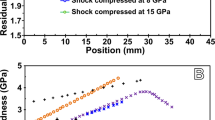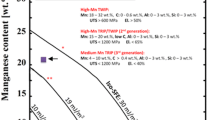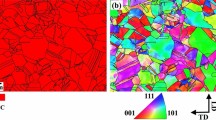Abstract
A TEM study of pure tantalum and tantalum-tungsten alloys explosively shocked at a peak pressure of 30 GPa (strain rate: ~1 × 104 sec-1) is presented. While no ω (hexagonal) phase was found in shock-recovered pure Ta and Ta-5W that contain mainly a low-energy cellular dislocation structure, shock-induced ω phase was found to form in Ta-10W that contains evenly distributed dislocations with a stored dislocation density higher than 1 × 1012 cm-2. The TEM results clearly reveal that shock-induced α (bcc) → ω (hexagonal) shear transformation occurs when dynamic recovery reactions which lead the formation low-energy cellular dislocation structure become largely suppressed in Ta-10W shocked under dynamic (i.e., high strain-rate and high-pressure) conditions. A novel dislocation-based mechanism is proposed to rationalize the transition of dislocation glide to twinning and/or shear transformation in shock-deformed tantalum. Twinning and/or shear transformation take place as an alternative deformation mechanism to accommodate high-strain-rate straining when the shear stress required for dislocation multiplication exceeds the threshold shear stresses for twinning and/or shear transformation.
Similar content being viewed by others
References
L.M. Hsiung and D.H. Lassila, Acta Mater., 48, 4851 (2000).
D.A. Young, !Phase Diagrams of the Elements, (University of California Press, Berkeley 1991).
E. Yu Tonkov, E.G. Ponyatovsky, !Phase Transformations of Elements under High Pressure (CRC Press, New York 2005), p. 239.
H. Cynn, C.S. Yoo, Phys. Rev. B, 59, 8526 (1999).
C.-H. Lu, E.N. Hahn, B.A. Remington, B.R. Maddox, E.M. Bringa, and M.A. Meyers, Sci. Reports, 5, 15064 (2015).
W.M. Isbell, !Shock Waves: Measuring the Dynamic Response of Materials (Imperial College Press, London 2005).
G.H. Campbell, G.C. Archbold, O.A. Hurricane, and P. L. Miller, J. of Appl. Phys., 101, 033540 (2007).
R.T. Barton, !in Numerical Astrophysics, edited by J.M. Centrella, J.M. LeBlanc, and R.L. Bowers (Jones and Bartlett, Boston 1985), p. 482.
S. K. Zikka, Y. K. Vohra, and R. Chidambaram, !Prog. in Mater. Sci. 27 245 (1982).
J. Weertman, J.R. Weertman, !Elementary Dislocation Theory (Oxford University Press, Oxford 1992).
E.M. Nadgornyi, Prog. in Mater. Sci., 31, 1 (1988).
Author information
Authors and Affiliations
Rights and permissions
About this article
Cite this article
Hsiung, L.L., Campbell, G.H. Transition of Dislocation Glide to Shear Transformation in Shocked Tantalum. MRS Advances 2, 1417–1428 (2017). https://doi.org/10.1557/adv.2017.236
Published:
Issue Date:
DOI: https://doi.org/10.1557/adv.2017.236




